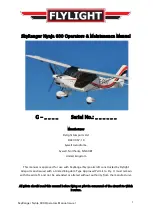
APAX evo user manual
________________________________________________________________________________________________________________________________________________________
Dangerous situations and extreme flying
WARNING: Extreme flight maneuvers with a full throttle engine are life-threatening and
cannot be tested! The following chapter describes how to avoid and correct extreme
situations. The descriptions of the test maneuvers refer to the starting weight without
engine.
Dangerous situations
Pilot error, extreme wind conditions or turbulence which goes unnoticed by the pilot for too
long may leave the wing in an unusual flying position, requiring special reaction and skills on
the part of the pilot. The best way to learn how to react calmly and correctly in a serious
situation is to attend safety training, where you will learn how to manage extreme situations
under the guidance of a professional.
Ground-training is another safe and effective method of familiarising yourself with your
glider’s reactions. Launch can be practised, as can small flying manoeuvres, such as stall,
asymmetric collapse, front stall etc.
Any pilot who flies in turbulent conditions or who makes an error in handling the glider is at
risk of getting into an extreme situation. All of the extreme flight figures and flight attitudes
described here are dangerous if they are carried out with inadequate knowledge, without the
right safety altitude or without training.
Always keep within the recommended limits. Avoid aerobatics and extreme loading such as
spirals and big ears. This will prevent accidents and avoid overloading the glider.
In turbulent conditions, always keep enough distance from rock faces and other obstacles.
Time and sufficient altitude are needed to recover from extreme situations.
WARNING: Deploy your reserve if the corrective manoeuvres described in the following
sections do not return the glider to a controllable flying position or if there is not enough
altitude for correction.
SIV / Safety training
Due to the advanced design features of the paraglider, collapses incorrectly induced by the
pilot may have more significant consequences than collapses collapses which may occur in
the course of normal flight (due to to turbulence etc.).
Taking part in safety training is in principle advisable in order to familiarise yourself with
your glider and the correct reactions in extreme situations. However, safety training also
subjects your equipment to extreme loads.
Material stress
During a safety training course, avoid subjecting the materials of your paraglider to excessive
stress. Uncontrolled flight positions may occur which are outside the manufacturer limits of
the paraglider. This may cause premature ageing, or even structural failure.
Page 27
Содержание APAX evo
Страница 1: ...User manual Version 1 0 Date August 2020...
Страница 52: ......














































